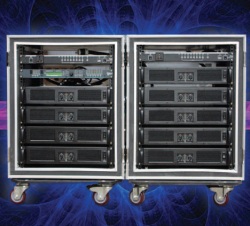
It is not often clear to consumers what this means and under what conditions it is measured (the fine print). All they see is a huge number with “watts” after it and may assume that it is a continuous rating.
There are other issues that complicate the generation of power. Reactive loads (like loudspeakers and transformers) produce a phase shift between the voltage and current. This reflects some of the applied power back at the amplifier and reduces the power delivered to the load. If you’ve ever used a reciprocating saw on a flexible panel, you have experienced mechanical reactance first hand.
So, there are several factors that decimate and nibble away at the rated power of a multi-kilowatt amplifier. The good news is that modern multi-kilowatt amplifiers have gotten pretty smart at being able to allow their massive instantaneous power to be utilized without tripping circuit breakers and burning up loads. I’ll revisit this in part 3.
Need For Conversations
To summarize, it is theoretically possible for a highly efficient audio power amplifier to produce continuous sine wave power in the 2 kW range. For it to actually have to do this is unlikely, given the nature of music and speech signals and the real-world impedances of loudspeakers.
Rating the amplifier based on a very low load impedance, tone burst signal and in linear units (”watts”) is definitely putting the best face on it. Just remember that the “KiloBlaster 10000” gets it rating based on the summed power from multiple channels under these “non typical” conditions.
Since no standard exists for “burst testing” amplifiers, you can bet that it is done differently by every manufacturer. This doesn’t make the numbers meaningless, but you won’t be able to use them to compare different makes and models. You’ll have to compare them the old-fashioned way – listening tests using a massive subwoofer (be sure to warn the neighbors).
In reality, the “KiloBlaster 10000” amplifier from one manufacturer may produce the essentially the same performance as the “SpeakerWelder 12000” from another, and the “ConeMelt 6000” from yet another. Their rated outputs are within 3 dB of each other, and this may not be audible under real-world conditions. They may actually measure about the same if tested in the same manner.
Our industry needs to have some serious conversations about power and power ratings for such numbers to be useful for comparison shopping. For now, give me continuous sine wave ratings that I can use to design sound systems. The reputable manufacturers do this already, but you’ll probably have to read the spec sheet, not the sales brochure, to find them.
Why does any of this matter? We need to keep it real. Idealized rating methods generate misunderstanding and unrealistic expectations among audio practitioners. The consultant who won’t specify an amplifier “under 2 kW” or a loudspeaker with a maximum SPL rating “less than 140 dB” is missing the boat and likely passing over some very good products.
The burden is on the audio professional to decipher the power rating into what they can expect when the amplifier is in their customer’s rack, not on the test bench.
In part 3 I will lay aside the theories and the musings and test some commercially available units under real-world conditions. Someone please warn the neighbors.
Click here to view/download a printable pdf of this article.
